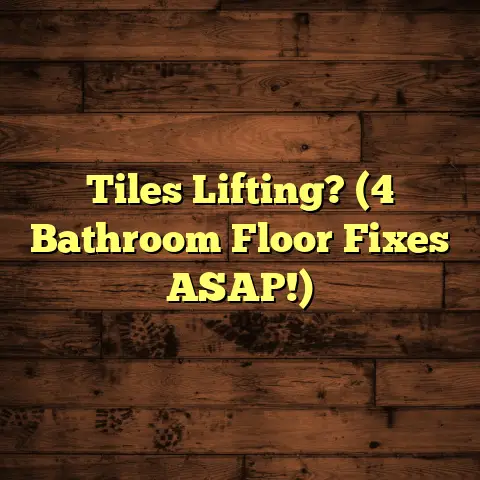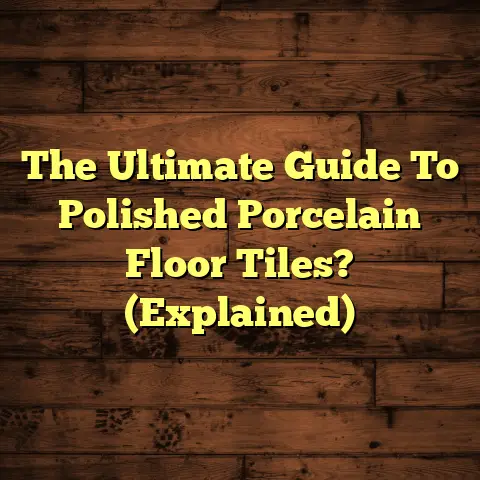Prep Concrete for Vinyl Planks? (4 Subfloor Secrets!)
We’re not just talking about slapping down some planks and hoping for the best. We’re diving deep into the often-overlooked but absolutely critical world of subfloor preparation.
And yes, we’re keeping it green with eco-friendly options!
Vinyl plank flooring is all the rage these days, and for good reason. It’s durable, beautiful, and relatively easy to install. But here’s the thing: even the best vinyl planks will fail if your concrete subfloor isn’t prepped correctly.
Trust me, I’ve seen it all – warping, uneven surfaces, and flooring that just doesn’t last.
So, grab a cup of coffee (or tea!), and let’s get started.
Section 1: Understanding Vinyl Plank Flooring
So, what exactly is vinyl plank flooring?
Well, it’s a multi-layered synthetic flooring product designed to mimic the look of natural wood or stone. Think of it as a high-tech upgrade to traditional vinyl.
It’s typically composed of several layers:
-
Wear Layer: This is the top layer, providing durability and resistance to scratches and stains.
-
Print Layer: This layer features the high-resolution image that gives the plank its realistic appearance.
-
Core Layer: This is the main structural component, often made of PVC or a composite material.
-
Backing Layer: This bottom layer provides stability and helps with sound absorption.
Now, what about the eco-friendly angle?
Many manufacturers are now using recycled materials and low-VOC (Volatile Organic Compounds) in their vinyl plank production.
Look for certifications like FloorScore or GreenGuard to ensure you’re choosing a sustainable option.
According to the Vinyl Institute, “Vinyl is recyclable, and post-consumer vinyl is increasingly being used in new products, reducing waste and conserving resources.”
Here’s why vinyl planks are a fantastic choice:
-
Resilience: They’re comfortable underfoot and can withstand heavy traffic.
-
Water Resistance: Perfect for kitchens, bathrooms, and basements.
-
Design Versatility: You can find vinyl planks that look like almost any type of wood or stone.
-
Easy Installation: Many vinyl planks feature a click-lock system, making DIY installation a breeze.
-
Cost-Effective: Generally more affordable than hardwood or natural stone.
More and more homeowners are prioritizing sustainable home renovations, and vinyl planks fit right into this movement. It’s a win-win: you get a beautiful and durable floor while minimizing your environmental impact.
Section 2: The Importance of Proper Subfloor Preparation
Okay, let’s get down to brass tacks. Why is subfloor preparation so crucial?
Think of your subfloor as the foundation of your entire flooring system. If it’s not solid, everything else will suffer.
Here’s the deal:
-
Warping and Buckling: An uneven subfloor can cause your vinyl planks to warp or buckle over time.
-
Uneven Surfaces: You’ll feel every bump and dip underfoot, which is not exactly a luxurious experience.
-
Reduced Lifespan: Improper preparation can significantly shorten the lifespan of your flooring.
-
Adhesive Failure: If the subfloor isn’t clean and properly primed, the adhesive may not bond correctly, leading to loose planks.
I’ve seen countless projects where homeowners tried to cut corners on subfloor prep, and it always comes back to bite them. Don’t make that mistake!
Eco-tech plays a vital role in subfloor preparation. We’re talking about using:
-
Low-VOC Adhesives: These adhesives release fewer harmful chemicals into the air, making for a healthier indoor environment.
-
Eco-Friendly Moisture Barriers: These barriers prevent moisture from seeping up through the concrete, protecting your flooring from water damage.
-
Recycled Leveling Compounds: Some self-leveling compounds are made from recycled materials, reducing waste and conserving resources.
By choosing these eco-friendly options, you’re not only ensuring a better result but also contributing to a more sustainable future.
Section 3: Four Essential Secrets for Preparing Concrete Subfloors
Alright, let’s dive into the nitty-gritty. Here are my four essential secrets for preparing concrete subfloors for vinyl plank installation:
1. Secret #1: Moisture Control
Moisture is the enemy of vinyl plank flooring. Concrete is porous, and moisture can wick up from the ground, causing all sorts of problems.
Before you even think about laying down any planks, you must test the moisture levels in your concrete subfloor.
Here are a few methods for testing moisture levels:
-
Calcium Chloride Test (Anhydrous Calcium Chloride Test): This is the most accurate method. A measured amount of calcium chloride is placed under a sealed dome on the concrete surface for 60-72 hours. The weight gain of the calcium chloride indicates the amount of moisture emitted.
-
Relative Humidity (RH) Test: A probe is inserted into a drilled hole in the concrete to measure the relative humidity within the slab.
-
Moisture Meter: A handheld device that measures the moisture content of the concrete surface. Note: This is less accurate than the other two methods but can give you a general idea of the moisture level.
So, what are the acceptable moisture limits for vinyl plank installation?
Generally, you’re looking for:
-
Calcium Chloride Test: Less than 3 lbs of moisture emission per 1,000 square feet in 24 hours.
-
Relative Humidity Test: Less than 75% RH.
If your moisture levels are too high, you’ll need to take action.
Here are some eco-friendly moisture barriers and sealers you can use:
-
Epoxy Moisture Barriers: These create a waterproof layer on top of the concrete. Look for low-VOC options.
-
Silane-Based Sealers: These penetrate the concrete and create a hydrophobic barrier. They’re a good choice for existing concrete slabs.
-
Polyurethane Sealers: These provide a durable and water-resistant finish. Again, opt for low-VOC formulations.
Remember, investing in a good moisture barrier is worth every penny. It’ll protect your flooring from water damage and extend its lifespan significantly.
2. Secret #2: Surface Cleaning and Leveling
A clean and level surface is essential for a successful vinyl plank installation.
Here’s how to clean your concrete surface:
-
Remove Debris: Sweep or vacuum the entire area to remove any loose dirt, dust, or debris.
-
Scrape Away Old Adhesives: Use a floor scraper to remove any old adhesive residue. You can also use a chemical adhesive remover, but be sure to choose a low-VOC option.
-
Clean Stains: Use a concrete cleaner to remove any stains or discoloration.
-
Rinse Thoroughly: Rinse the entire surface with clean water and allow it to dry completely.
Now, let’s talk about leveling.
An uneven surface will cause your vinyl planks to look unsightly and can even lead to premature wear and tear.
Here are a few methods for leveling your concrete subfloor:
-
Self-Leveling Compound: This is the most common method. Pour the compound onto the floor and it will spread out evenly, creating a smooth surface. Look for self-leveling compounds made from recycled materials.
-
Grinding: For minor imperfections, you can use a concrete grinder to smooth out the surface.
-
Patching: For small holes or cracks, use a concrete patching compound.
An even surface contributes to the longevity and appearance of your vinyl planks in several ways:
-
Even Weight Distribution: Prevents stress points and reduces the risk of warping or buckling.
-
Proper Adhesion: Ensures that the adhesive bonds correctly to the subfloor.
-
Aesthetics: Creates a smooth and seamless look.
3. Secret #3: Addressing Cracks and Imperfections
Cracks and imperfections in your concrete subfloor can cause serious problems down the road.
Here’s how to identify and repair them:
-
Inspect the Surface: Carefully examine the entire subfloor for cracks, holes, and other imperfections.
-
Clean the Cracks: Use a brush or vacuum to remove any debris from the cracks.
-
Fill the Cracks: Use a concrete patching compound to fill the cracks. For larger cracks, you may need to use a crack filler specifically designed for concrete.
-
Smooth the Surface: Use a trowel to smooth the patching compound so that it’s flush with the surrounding surface.
Here are some eco-friendly patching compounds you can use:
-
Cement-Based Patching Compounds: These are a good choice for general repairs. Look for products that contain recycled content.
-
Epoxy Patching Compounds: These are more durable and water-resistant. Opt for low-VOC formulations.
Ensuring a smooth surface is crucial for avoiding future issues with your vinyl plank installation:
-
Prevents Cracking: Prevents cracks from propagating through the vinyl planks.
-
Ensures Stability: Provides a stable base for the flooring.
-
Improves Appearance: Creates a smooth and seamless look.
4. Secret #4: Choosing the Right Underlayment
Underlayment is a thin layer of material that is installed between the subfloor and the vinyl planks. It plays a vital role in the performance and longevity of your flooring.
Here’s what underlayment does:
-
Sound Absorption: Reduces noise transmission, making your home quieter.
-
Moisture Control: Provides an extra layer of protection against moisture.
-
Comfort: Adds cushioning underfoot, making your floors more comfortable to walk on.
-
Leveling: Can help to smooth out minor imperfections in the subfloor.
Here are some eco-friendly underlayment options:
-
Cork Underlayment: Cork is a natural and sustainable material that provides excellent sound absorption and insulation.
-
Recycled Rubber Underlayment: Made from recycled tires, this underlayment is a great way to reduce waste.
-
Felt Underlayment: Made from recycled fibers, felt underlayment is a soft and comfortable option.
Choosing the right underlayment contributes to the overall sustainability of your flooring project:
-
Reduces Noise Pollution: Creates a quieter and more peaceful home environment.
-
Conserves Resources: Utilizes recycled materials, reducing waste and conserving resources.
-
Improves Comfort: Makes your floors more comfortable to walk on, reducing fatigue and improving overall well-being.
Conclusion
So, there you have it – my four essential secrets for preparing concrete subfloors for vinyl plank installation.
Remember, proper preparation is the key to a long-lasting and beautiful floor.
Don’t skip any steps, and be sure to choose eco-friendly options whenever possible.
By investing time and resources into subfloor preparation, you’ll not only get a stunning floor but also contribute to a more sustainable future.
Now, go forth and create the flooring of your dreams! You got this!





